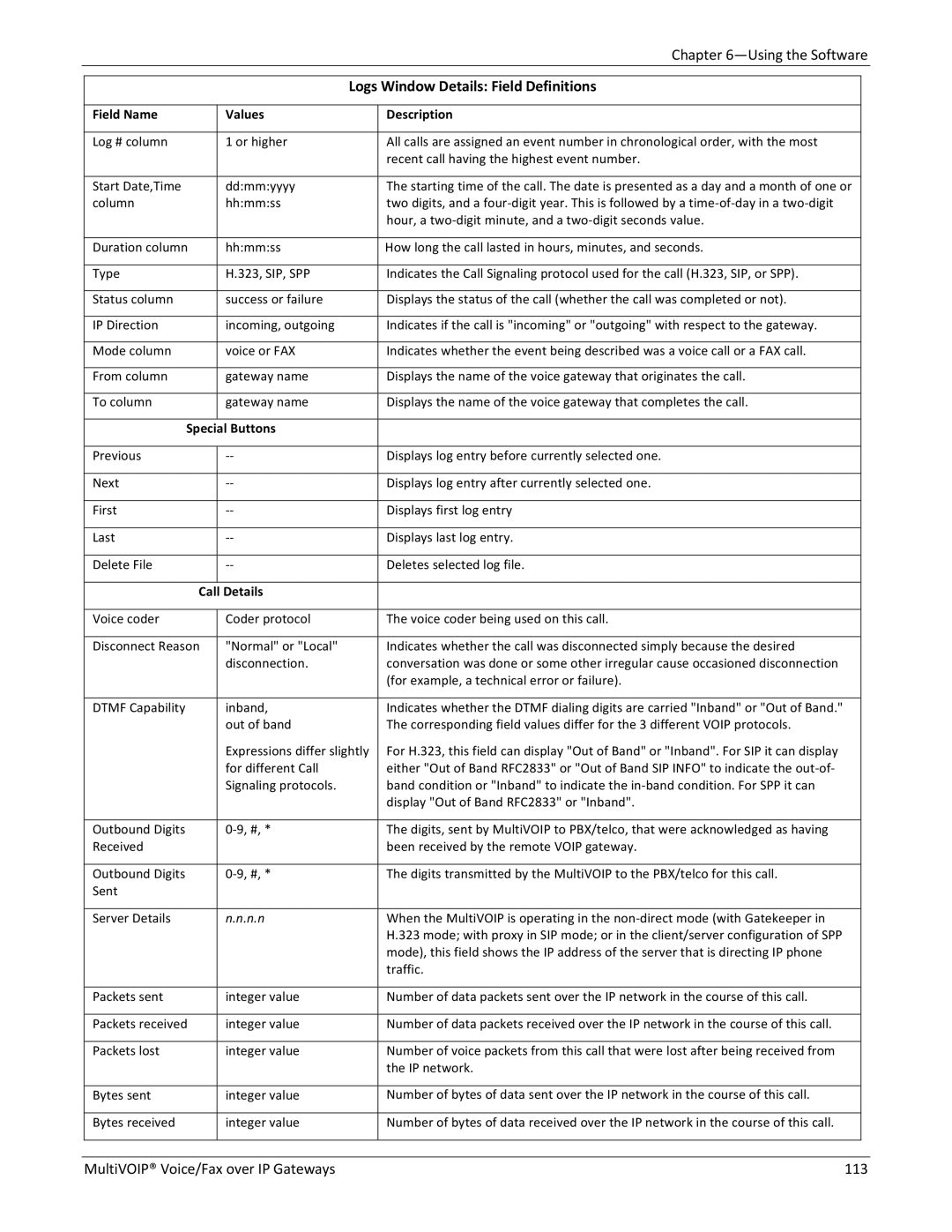
Chapter
Logs Window Details: Field Definitions
Field Name | Values |
|
|
Log # column | 1 or higher |
|
|
Start Date,Time | dd:mm:yyyy |
column | hh:mm:ss |
|
|
Duration column | hh:mm:ss |
|
|
Type | H.323, SIP, SPP |
|
|
Status column | success or failure |
|
|
IP Direction | incoming, outgoing |
|
|
Mode column | voice or FAX |
|
|
From column | gateway name |
|
|
To column | gateway name |
|
|
Special Buttons | |
|
|
Previous | ‐‐ |
|
|
Next | ‐‐ |
|
|
First | ‐‐ |
|
|
Last | ‐‐ |
|
|
Delete File | ‐‐ |
|
|
Call Details | |
|
|
Voice coder | Coder protocol |
|
|
Disconnect Reason | "Normal" or "Local" |
| disconnection. |
|
|
DTMF Capability | inband, |
| out of band |
| Expressions differ slightly |
| for different Call |
| Signaling protocols. |
|
|
Outbound Digits | 0‐9, #, * |
Received |
|
|
|
Outbound Digits | 0‐9, #, * |
Sent |
|
|
|
Server Details | n.n.n.n |
Packets sent | integer value |
|
|
Packets received | integer value |
|
|
Packets lost | integer value |
|
|
Bytes sent | integer value |
|
|
Bytes received | integer value |
Description
All calls are assigned an event number in chronological order, with the most recent call having the highest event number.
The starting time of the call. The date is presented as a day and a month of one or two digits, and a four‐digit year. This is followed by a time‐of‐day in a two‐digit hour, a two‐digit minute, and a two‐digit seconds value.
How long the call lasted in hours, minutes, and seconds.
Indicates the Call Signaling protocol used for the call (H.323, SIP, or SPP).
Displays the status of the call (whether the call was completed or not).
Indicates if the call is "incoming" or "outgoing" with respect to the gateway.
Indicates whether the event being described was a voice call or a FAX call.
Displays the name of the voice gateway that originates the call.
Displays the name of the voice gateway that completes the call.
Displays log entry before currently selected one.
Displays log entry after currently selected one.
Displays first log entry
Displays last log entry.
Deletes selected log file.
The voice coder being used on this call.
Indicates whether the call was disconnected simply because the desired conversation was done or some other irregular cause occasioned disconnection (for example, a technical error or failure).
Indicates whether the DTMF dialing digits are carried "Inband" or "Out of Band." The corresponding field values differ for the 3 different VOIP protocols.
For H.323, this field can display "Out of Band" or "Inband". For SIP it can display either "Out of Band RFC2833" or "Out of Band SIP INFO" to indicate the out‐of‐ band condition or "Inband" to indicate the in‐band condition. For SPP it can display "Out of Band RFC2833" or "Inband".
The digits, sent by MultiVOIP to PBX/telco, that were acknowledged as having been received by the remote VOIP gateway.
The digits transmitted by the MultiVOIP to the PBX/telco for this call.
When the MultiVOIP is operating in the non‐direct mode (with Gatekeeper in H.323 mode; with proxy in SIP mode; or in the client/server configuration of SPP mode), this field shows the IP address of the server that is directing IP phone traffic.
Number of data packets sent over the IP network in the course of this call.
Number of data packets received over the IP network in the course of this call.
Number of voice packets from this call that were lost after being received from the IP network.
Number of bytes of data sent over the IP network in the course of this call.
Number of bytes of data received over the IP network in the course of this call.
MultiVOIP® Voice/Fax over IP Gateways | 113 |
